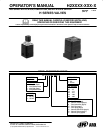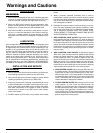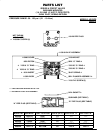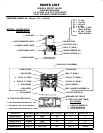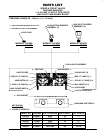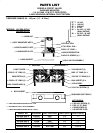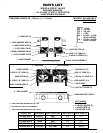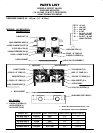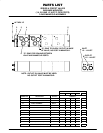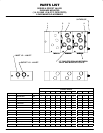
H Series Valves2OF12
Warnings
and Cautions
APPLICATION
WARNINGS:
1. ARO
valves are designed for use only in industrial
pneumatic
(air) and / or vacuum systems applications and are NOT to be
used
for individual consumer use, application or service.
2. When any ARO valve is used in any type application, safe-
guards
must be provided to insure against bodily injury for the
operator
and / or other persons in the immediate area.
3. ARO
valves are NOT to be used as a safety device or to oper
-
ate
and /
or control the operation of full revolution clutch sys
-
tems and / or brake systems on power presses or similar
equipment.
ARO valves are not designed or intended for such
uses.
LUBRICATION
Valve components are lubricated at the time of assembly at the
factory
and
can normally be operated without air line lubrication to
an approximate life of twenty million cycles, depending on ap-
plication.
If air line cylinders or other air line devices, used in con
-
junction
with ARO valves, require lubrication, be sure the
lubricat
-
ing oils used are compatible with the valve seals and are of
sufficient viscosity to assure adequate lubrication. Aro recom-
mends
an oil lubricant
with a viscosity of 100 - 200 SUS at 100
_
F
and
an aniline point above 200
_
F
. Aro does not recommend the
use of compound oils containing graphite fillers, extremely low
viscosities and other non-fluidic lubricants. RECOMMENDED:
Aro
29665 air line lubricator oil is
available in one quart containers.
INSTALLATION
AND SER
VICE
WARNINGS:
1. Shut
of
f, disconnect and exhaust air pressure from system be
-
fore
installing or performing service to any ARO valve.
2. Shut off and disconnect electrical supply to system before
installing
or performing service to any ARO valve.
3.
Allow only persons with a thorough understanding
of the op
-
eration
and application of all ARO valves being used in a par
-
ticular
system and how the ARO
valve(s) relate to and interact
with other components of the system to install or perform
maintenance or service to any ARO valve or other compo-
nents
of the system.
4. DO
NOT subject any ARO valve to any condition that exceeds
the limits set forth in the specifications for a particular valve
model.
5. When a manually operated (actuated) valve is used or
installed into a system, provisions must be made to prevent
the
valve from being accidentally operated (actuated), which
may in turn cause bodily injury or otherwise cause a hazard
-
ous or dangerous condition
6. Damaged air pressure hoses
or electrical wiring, or connec
-
tions,
can cause accidental valve operation (actuation), which
may
in turn cause
bodily injury or otherwise cause a hazard
-
ous or dangerous condition. KEEP ALL HOSES, ELEC-
TRICAL
WIRING,
FITTINGS AND CONNECTIONS IN FIRST
CLASS
OPERA
TING CONDITION.
7.
ARO 2-POSITION, 4-W
AY
V
AL
VES:
Regardless of which of
the
2-positions this type of ARO valve
is in, when air pressure
is applied
to
the inlet port(s) of these valves, there will always
be an open flow path of air from the inlet to one
of the valve
outlets.
A method to exhaust this trapped air pressure must be
installed into the system so all air pressure can be
removed
from valve or system before performing service or mainte-
nance
to valve.
8. ARO
3-POSITION,
4-W
AY VALVES: To actuate this type of
ARO valve, either a double
solenoid, double remote air pilot
pressure
or manual operation is used. When the valve
actua
-
tor has shifted the valve, air pressure applied at the inlet
port(s) will flow thru the valve to one of the two outlet
ports.
When
the valve is not in a shifted position, the valve will auto
-
matically
move to a center position. ARO valves can be either
closed center or open center type and will reveal the following
characteristics
when the valve is in the center position:
a. OPEN
CENTER V
ALVES:
When this type ARO valve is
in
the
center position, the
inlet port(s) is blocked and the two
outlet ports are open to the exhaust port(s) of the valve.
With this type valve, in the center position, air pressure
is
not present at either outlet port. Do not use this type ARO
valve if exhausting the air pressure from the valve will
cause
hazardous or dangerous condition.
b. CLOSED
CENTER V
ALVES:
When this type valve is in the
center position, all inlet, outlet and exhaust ports are
blocked.
Do not use this
type valve if having the air pressure
blocked at the port(s) may cause a hazardous or danger-
ous
condition in the application, installation and / or servic
-
ing
of an ARO valve. These valves must not be used to con
-
trol
load holding
devices without an additional mechanical
positive stop on the holding device.



